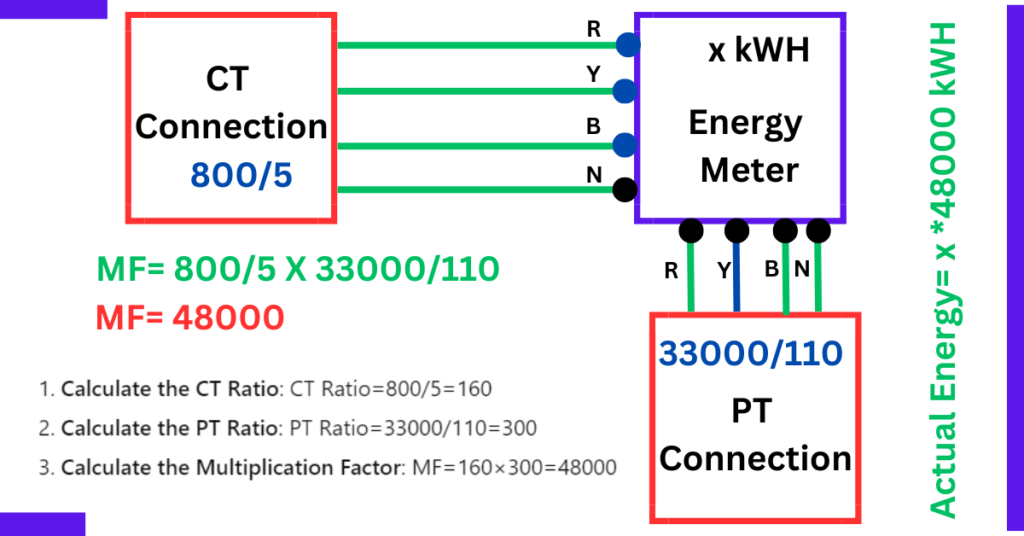This article explains the multiplication of an energy meter, its definition, formula, and calculations. Energy meters are essential tools for measuring the electrical energy consumption of residential, commercial, and industrial users. To ensure these measurements are accurate, applying the Multiplication Factor (MF) correctly is important. The MF adjusts the raw readings from the energy meter, accounting for the effects of current transformers (CTs) and potential transformers (PTs).
What is the Multiplication Factor?
The Multiplication Factor (MF) of an energy meter is a scaling factor that converts the raw readings from the meter into accurate values of actual energy consumption. This factor is necessary to compensate for the reduction in high currents and voltages by CTs and PTs, ensuring the meter readings are precise.
Importance of the Multiplication Factor of Energy Meter
- Accuracy: Ensures the energy meter readings accurately reflect actual energy usage.
- Billing: Provides a correct basis for billing consumers, preventing overcharging and undercharging.
- Energy Management: Assists in effectively monitoring and managing energy consumption.
How to Calculate the Multiplication Factor of Energy Meter
The MF is calculated based on the characteristics of the CTs and PTs used with the energy meter. It is expressed as:

where:
- CT Ratio: The ratio of the primary current to the secondary current
- PT Ratio: The ratio of the primary voltage to the secondary voltage (meter input).
Steps to Calculate the Multiplication Factor
The multiplication factor of energy meters can be calculated by calculating the ratios of CT and PT. You need to calculate the following;
- CT Ratio
- PT Ration
Step 1: Find the CT Ratio
You can find the primary and secondary current data on the CT nameplate. Divide the primary current(Ip) by the secondary current(Is) to calculate the CT ratio.

Step 2: Find the PT Ratio
You can find the primary and secondary voltage data on the potential transformer nameplate. Divide the primary voltage (Vp) by the secondary voltage(Vs) to calculate the PT ratio.

Step 3: Calculate the Multiplication Factor
Multiply the CT ratio by the PT ratio to find the multiplying factor

Illustrative Example for MF Calculation
An energy meter is fed with CT and PT, and the ratios of CT and PT are 800/5 and 33kV/110V, respectively. Let’s calculate the energy meter’s multiplying factor.

- Calculate the CT Ratio: CT Ratio=800/5=160
- Calculate the PT Ratio: PT Ratio=33000/110=300
- Calculate the Multiplication Factor: MF=160×300=48000
Thus, the Multiplication Factor of the energy meter is 48,000. This means the energy data read by the energy meter must be multiplied by 48,000 to obtain the actual energy consumption.
For example, if the meter reads 60 kWh, the actual energy consumption is:
Actual Energy Consumption=Meter Reading×MF=60×48000=2,880,000 kWh
Conclusion
It is crucial to calculate the Multiplication Factor of energy meters accurately to ensure precise energy measurement and billing. By properly applying the CT and PT ratios, both utility companies and consumers can have confidence that the recorded energy usage accurately reflects actual consumption. This accuracy is essential for fair billing, effective energy management, and overall reliability in the energy system. Understanding and correctly applying the MF is essential for all energy distribution and consumption stakeholders.
Related Articles:
- Transformer Core Saturation
- Voltage and Current
- Capacitive Voltage Transformer
- Clamp Meter Working Principle, Diagram & Uses
- Appliances Power Consumption in kWh (With Examples)
- HP to KW Calculator- Horsepower to KW Calculator
- Three-Phase Power Formula
- Difference Between kW and kWh: Definitions & Examples
- How to Calculate Electricity Bill from kWh (Units)
- UNIT(kWh)